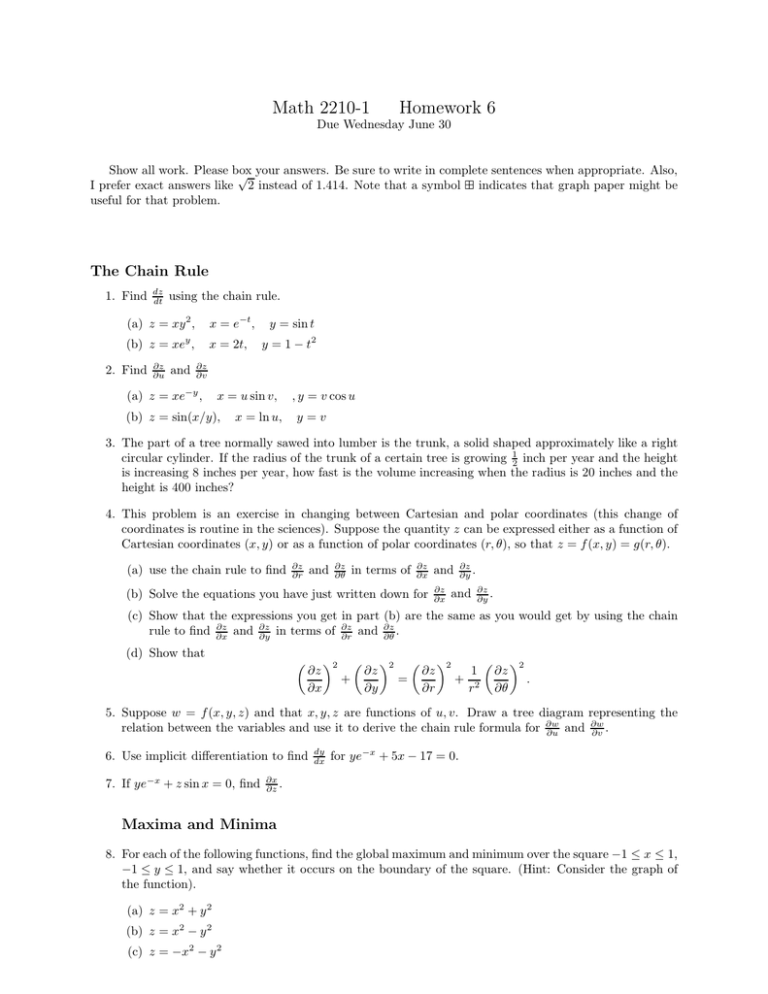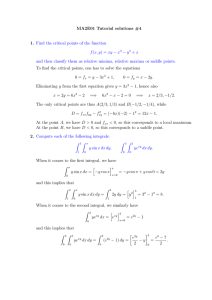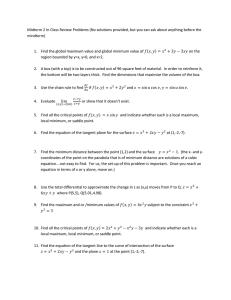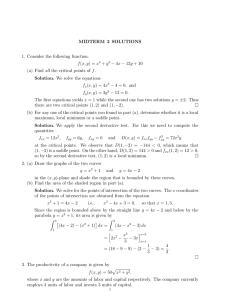Math 2210-1 Homework 6
advertisement

Math 2210-1 Homework 6 Due Wednesday June 30 Show all work. Please box √ your answers. Be sure to write in complete sentences when appropriate. Also, I prefer exact answers like 2 instead of 1.414. Note that a symbol indicates that graph paper might be useful for that problem. The Chain Rule 1. Find dz dt using the chain rule. (a) z = xy 2 , x = e−t , y (b) z = xe , 2. Find ∂z ∂u and x = 2t, y = sin t y = 1 − t2 ∂z ∂v (a) z = xe−y , x = u sin v, (b) z = sin(x/y), x = ln u, , y = v cos u y=v 3. The part of a tree normally sawed into lumber is the trunk, a solid shaped approximately like a right circular cylinder. If the radius of the trunk of a certain tree is growing 12 inch per year and the height is increasing 8 inches per year, how fast is the volume increasing when the radius is 20 inches and the height is 400 inches? 4. This problem is an exercise in changing between Cartesian and polar coordinates (this change of coordinates is routine in the sciences). Suppose the quantity z can be expressed either as a function of Cartesian coordinates (x, y) or as a function of polar coordinates (r, θ), so that z = f (x, y) = g(r, θ). (a) use the chain rule to find ∂z ∂r and ∂z ∂θ in terms of ∂z ∂x (b) Solve the equations you have just written down for ∂z ∂y . and ∂z ∂x and ∂z ∂y . (c) Show that the expressions you get in part (b) are the same as you would get by using the chain ∂z ∂z ∂z rule to find ∂x and ∂z ∂y in terms of ∂r and ∂θ . (d) Show that ∂z ∂x 2 + ∂z ∂y 2 = ∂z ∂r 2 1 + 2 r ∂z ∂θ 2 . 5. Suppose w = f (x, y, z) and that x, y, z are functions of u, v. Draw a tree diagram representing the ∂w relation between the variables and use it to derive the chain rule formula for ∂w ∂u and ∂v . 6. Use implicit differentiation to find 7. If ye−x + z sin x = 0, find dy dx for ye−x + 5x − 17 = 0. ∂x ∂z . Maxima and Minima 8. For each of the following functions, find the global maximum and minimum over the square −1 ≤ x ≤ 1, −1 ≤ y ≤ 1, and say whether it occurs on the boundary of the square. (Hint: Consider the graph of the function). (a) z = x2 + y 2 (b) z = x2 − y 2 (c) z = −x2 − y 2 9. Each of the following functions has a critical point at (0, 0). What sort of critical point is it? See if you can do this without using the Second Derivative Test. (a) f (x, y) = x4 + y 4 (b) g(x, y) = x6 + y 5 (c) h(x, y) = cos x cos y 10. Find the local maxima, local minima, and saddle points of the function f (x, y) = x2 + y 3 − 3xy. 11. Suppose that for some function f (x, y) at the point (a, b), we have fx = fy = 0, fxx > 0, fyy > 0, fxy = 0. (a) What can you conclude about the behavior of the function near the point (a, b)? (b) Sketch a possible contour diagram. 12. Suppose that for some function f (x, y) at the point (a, b), we have fx = fy = 0, fxx > 0, fyy = 0, fxy > 0. (a) What can you conclude about the behavior of the function near the point (a, b)? (b) Sketch a possible contour diagram. 13. (See http://www.math.hmc.edu/faculty/gu/curves and surfaces /surfaces/monkey.html) The hyperbolic paraboloid f (x, y) = xy is often called a saddle surface, because a person could sit on it comfortably. A monkey, however, would run into trouble because he would have nowhere to put his tail! The below surface is called a monkey saddle, because it has a convenient dip in the back to accommodate the monkey’s tail. The monkey saddle is the graph of the function g(x, y) = x3 − 3xy 2 . In this problem we will compare these two functions. (a) Verify that (0, 0) is indeed a saddle point for both the hyperbolic paraboloid (human saddle) and the monkey saddle. (b) Now we make new functions: F (x, y) = f (x, y) + 3x = xy + 3x G(x, y) = g(x, y) + 3x = x3 − 3xy 2 + 3x. This has the result of tilting the graph slightly, without changing its shape. Explain, in words, why this is the case. (c) Find the critical points of the new functions F (x, y) and G(x, y) (the tilted saddles). (d) What kind of critical points are they? (e) Summarize, in words, what happened to the saddle points of f (x, y) and g(x, y) after we tilted their graphs. Legrange’s Method 14. Use Lagrange multipliers to find the maximum and minimum values of f (x, y) subject to the given constraints. (a) f (x, y) = x + y, x2 + y 2 = 1 (b) f (x, y) = x2 + y, (c) f (x, y) = xy, x2 − y 2 = 1 4x2 + y 2 = 8 15. Design a closed cylindrical container which holds 100cm3 and has the minimal possible surface area. What should its dimensions be? Double Integrals over Rectangles 16. Let R be the rectangle with vertices (0, 0), (4, 0), (4, 4), and (0, 4) and let f (x, y) = √xy. Z f dA without subdividing R. (a) Find reasonable upper and lower bounds for R Z f dA by partitioning R into four subrectangles and evaluating f at its maximum and (b) Estimate R minimum values on each subrectangle. 17. A biologist studying insect populations measures the population density of flies and mosquitos at various points in a rectangular study region. The graphs of the two population densities for the region are shown below. Assuming that the units along the corresponding axes are the same in the two graphs, are there more flies or more mosquitos in the region? Why? (a) (b) Iterated Integrals 18. Evaluate the given integrals: Z √ x + y dA, where R is the rectangle 0 ≤ x ≤ 1, 0 ≤ y ≤ 2. (a) R Z (b) (5x2 + 1) sin 3y dA, where R is the rectangle −1 ≤ x ≤ 1, 0 ≤ y ≤ π3 . R Z (2x + 3y)2 dA, where R is the triangle with vertices at (−1, 0), (0, 1) and (1, 0). (c) R 19. For each of the regions R below, set up R R f dA as an iterated integral. y y 1 2 -1 1 (a) 1 y 2 3 4 x (b) 2 1 3 x -2 y 2 3 2 1 1 (c) 20. 1 3 4 x (d) 1 2 3 x For each of the following integrals, sketch the region of integration and evaluate the integral Z 3 Z 4 (a) 2 Z x (b) Z 5 Z 2x (c) Z 1 1 (d) Z 1 (e) Z ex+y dy dx 0 0 2 ex dy dx 0 sin(x) dy dx x 4Z y √ 0 −2 21. 2 x2 y 3 dx dy y 4 Z √ − 9−x2 2xy dy dx Consider the integral Z 0 4 Z −(y−4)/2 g(x, y) dx dy. 0 (a) Sketch the region over which the integration is being performed. (b) Write the integral with the order of integration reversed. 22. Evaluate the following integrals by reversing the order of integration. Z 1Z 1 p (a) 2 + x3 dx dy √ y 0 1 Z 1 (b) Z 3 Z 9 (c) Z Z 0 Z 2x+8 0 y −4 23. y sin(x2 ) dx dy y2 0 (d) 2 ex dx dy f (x, y) dy dx + Z 0 0 −4 Z 2x+8 f (x, y) dy dx 0 Find the average distance to the x-axis for points in the region bounded by the x-axis and the graph of y = x − x2 . 24. Evaluate Z 1Z (a) 0 (b) Z 0 1 sin(x2 ) dx dy y 1 Z e ey x dx dy ln x



